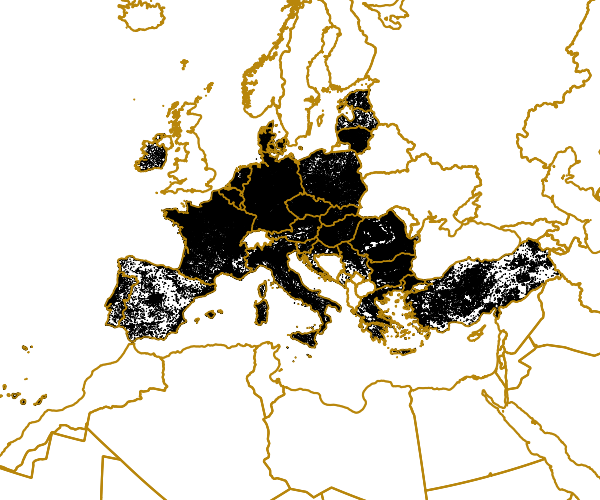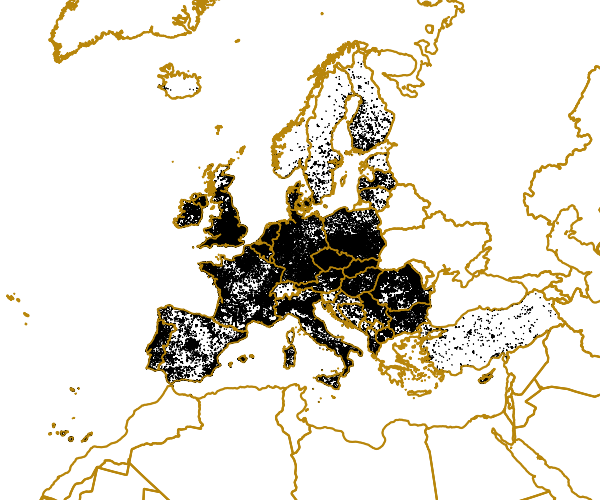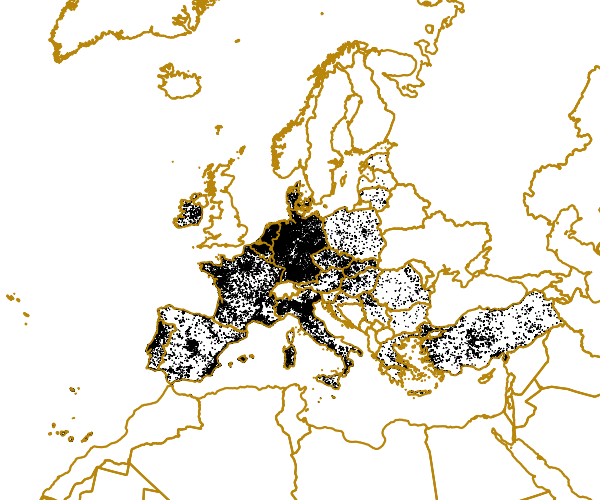Planning cadastre
Type of resources
Available actions
Topics
INSPIRE themes
Keywords
Contact for the resource
Provided by
Years
Formats
Representation types
Update frequencies
Scale
Resolution
-
The cadastral map is a key component of the national cadastre. It illustrates all property boundaries and ownership data from across Denmark. It also provides information about protected forests, coastal erostion areas and cliff protection. The cadastral map is a digital legal document. It is intended to present the cadastral register in visual form, such that individual parcels can be identified along with their attribute data (cadastral number, road access, etc.). The cadastral map is also used to determine precisely where property boundaries exist in the landscape, especially when 'actual' boundaries do not match the official 'paper' property boundaries exactly.
-
Owners of real estate, real estate agents, lawyers, land surveyors, public authorities and others need to know if a forest is preservation. This is an important information, because areas must be driven by the forestry rules on sustainable operation. A forest that is required for preservation must consist of trees that either form or are growing up to the forest of tall trees. Mosses, herds, meadows and the like, which naturally belong to a peace forest, must be preserved as they are, regardless of size. The preservation obligation follows the property. This means that a new owner always takes over the peace forest duty upon purchase of the property. Preservation duty is preceded by other rights, and does not lapse if the property is on a forced sale.
-
The data set contains spatial features connected as a hydrographic network represented by streams, lakes etc. The source for the data set is Geodanmark's feature type Watercourse.
-

An urban morphological zone (UMZ) is defined as a "set of urban areas laying less than 200 m apart". This layer contains UMZ delineations for Europe, based on Corine Land Cover database. During 2012, the UMZ methodology was updated in order to correct errors derived for the water course as join elements between urban areas. Previous version applied over CLC v15 (and previous version) joined many small urban areas due to the water presence. This fact was erroneous from the landscape and urban perspective as most of those areas remain as urban-rural typologies. Moreover, water courses cannot be considered as roads from the urban morphological view (either from the commuting point of understanding). This new version, known as v16, corrected this effect in the majority of cases.
-

The European Settlement Map 2015 (ESM_2015) is a spatial raster dataset that is mapping human settlements in Europe (EEA39) based on Copernicus Very High Resolution optical coverage for reference year 2015 (VHR_IMAGE_2015). It is produced with the Global Human Settlement Layer (GHSL) technology of the Joint Research Centre (JRC) in collaboration with the Directorate General of Regional and Urban Policy. It follows-up on the previous ESM2012_R2016 and ESM2012_R2017 derived from 2.5 m resolution SPOT-5/6 images acquired in the context of the pan-European GMES/Copernicus (Core_003) dataset for the reference year 2012. This metadata refers to the level 3 layer of ESM_2015. The level 3 layer delivers the following city-based layers: open spaces, a distance layer that contains the Euclidean distances from built-up pixels to open spaces and green in open spaces. The pixel size for level 3 layer is 10 m and the extent of each city is defined by the urban centres database. The level 3 layer is calculated for 888 cities. Open spaces are binary layers, while the distances to open spaces are continuous layers (float data type). The distance is expressed in number of pixels. To derive the distance in meters, it has to be multiplied by 10 corresponding to the pixel size in meters. The NDVI layer is provided with a full EEA-39 coverage tiled into 100 x 100 km tiles (tile index available in the following shapefile : index_NDVI.shp). The other layers are provided by urban city centers. ESM_2015 offers new opportunities in Earth observation related research by allowing to study urbanisation and related features across Europe in urban and rural areas, from continental to country perspective, from regional to local, until single blocks. IMPORTANT NOTE: This metadata refers to the Level 3 classification, which includes scientific datasets available upon request. The metadata has been prepared by the EEA on a third party dataset and is to be used for internal purposes. The following datasets are available through this metadata (see README file provided with the dataset): ESM_2015 level-3 NDVI ESM_2015 level-3 Open spaces ESM_2015 level-3 Distances in meters from built-up areas to open spaces For more information about the dataset please contact the owner. For general information on ESM and download: https://ghsl.jrc.ec.europa.eu/download.php?ds=ESM.
-

Metropolitan regions 2021 are NUTS 3 regions or a combination of NUTS 3 regions which represent all agglomerations of at least 250 000 inhabitants. Version 2021 is based on NUTS 2021, based on the Commission Delegated Regulation 2019/1755. These agglomerations were identified using the Urban Audit's Functional Urban Area (FUA). Each agglomeration is represented by at least one NUTS 3 region. If in an adjacent NUTS 3 region more than 50% of the population also lives within this agglomeration, it is included in the metro. For more information see: https://ec.europa.eu/eurostat/web/metropolitan-regions/background https://ec.europa.eu/eurostat/statistics-explained/index.php/Territorial_typologies_manual_-_metropolitan_regions IMPORTANT NOTE: This metadata is adapted from the corresponding Eurostat GISCO metadata and it is intended only for internal EEA use.
-

An urban morphological zone (UMZ) is defined as a "set of urban areas laying less than 200 m apart". This layer contains UMZ delineations for Europe, based on Corine Land Cover database. During 2012, the UMZ methodology was updated in order to correct errors derived for the water course as join elements between urban areas. Previous version applied over CLC v15 (and previous version) joined many small urban areas due to the water presence. This fact was erroneous from the landscape and urban perspective as most of those areas remain as urban-rural typologies. Moreover, water courses cannot be considered as roads from the urban morphological view (either from the commuting point of understanding). This new version, known as v16, corrected this effect in the majority of cases.
-

An urban morphological zone (UMZ) is defined as a "set of urban areas laying less than 200 m apart". This layer contains UMZ delineations for Europe, based on Corine Land Cover database. During 2012, the UMZ methodology was updated in order to correct errors derived for the water course as join elements between urban areas. Previous version applied over CLC v15 (and previous version) joined many small urban areas due to the water presence. This fact was erroneous from the landscape and urban perspective as most of those areas remain as urban-rural typologies. Moreover, water courses cannot be considered as roads from the urban morphological view (either from the commuting point of understanding). This new version, known as v16, corrected this effect in the majority of cases.
-

Changes between UMZs in 2000 and UMZs in 2006 using CLC version 16. Most changes are Positive changes, understood as areas of urban sprawl (i.e. new UMZ areas between 2000 and 2006), while negative changes describe the reduction of a certain UMZ between 2000 and 2006 (warning: some negative changes might be due to different interpretations between 2000-2006).
-

Changes between UMZs in 1990 and UMZs in 2000 using CLC version 16. Most changes are Positive changes, understood as areas of urban sprawl (i.e. new UMZ areas between 1990 and 2000), while negative changes describe the reduction of a certain UMZ between 1990 and 2000 (warning: some negative changes might be due to different interpretations between 1990-2000).
 RUC Geo-Data catalogue
RUC Geo-Data catalogue